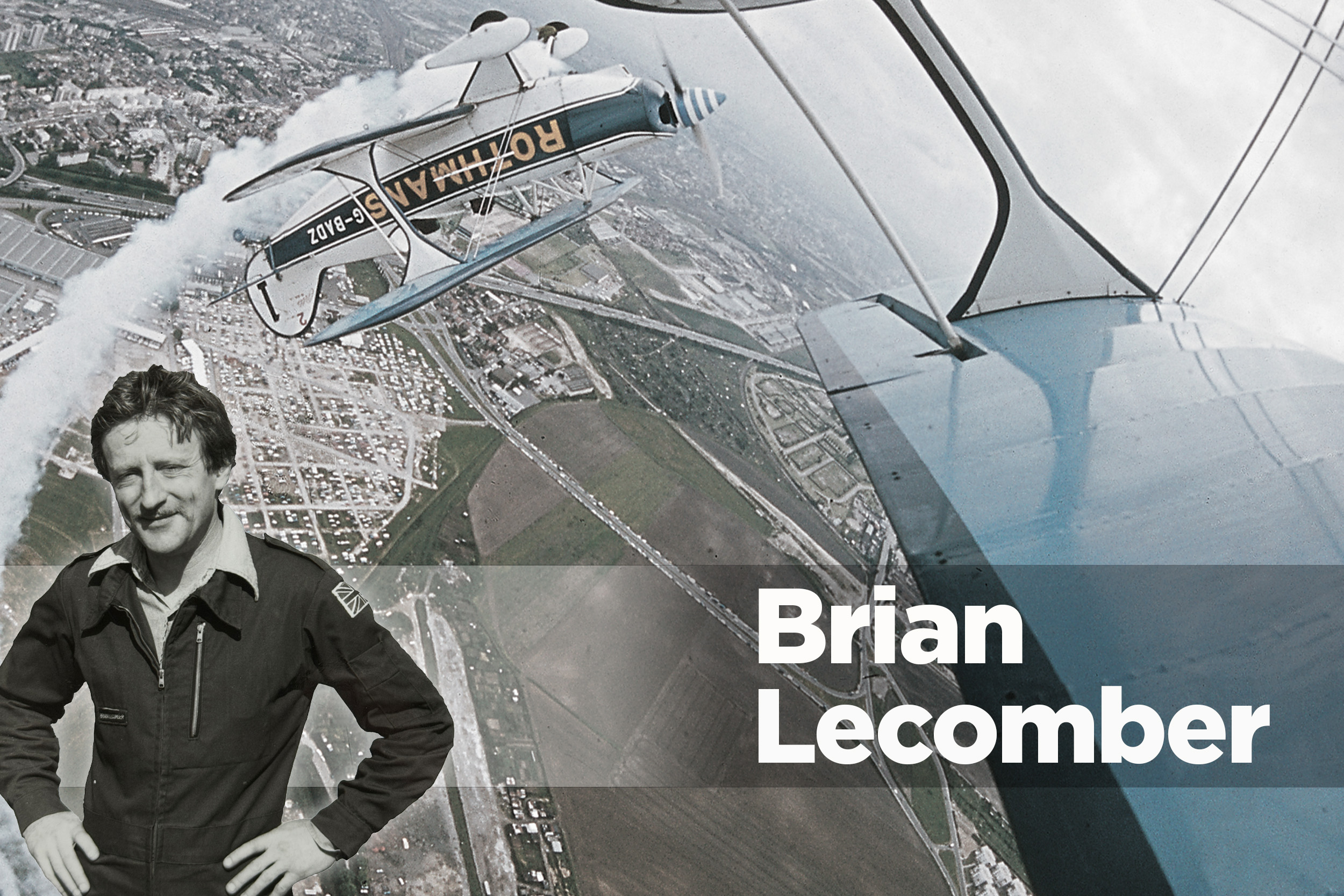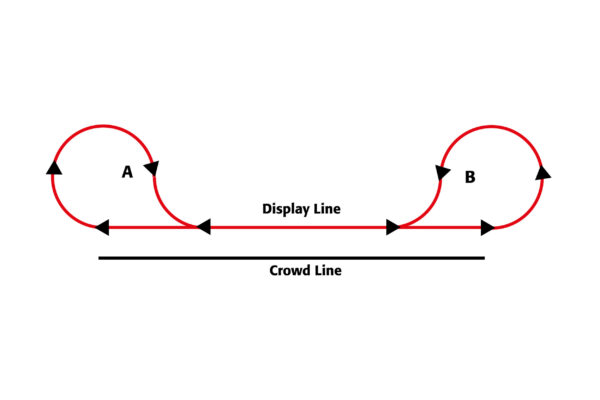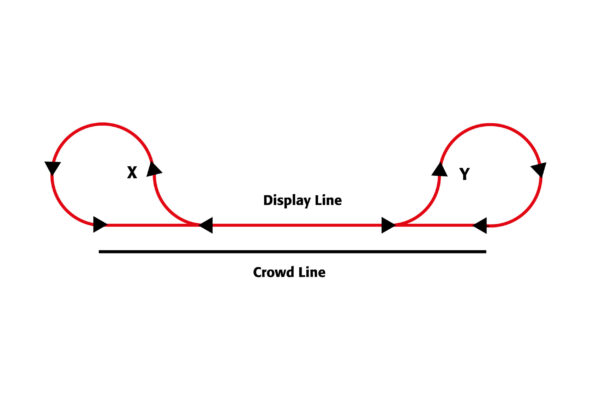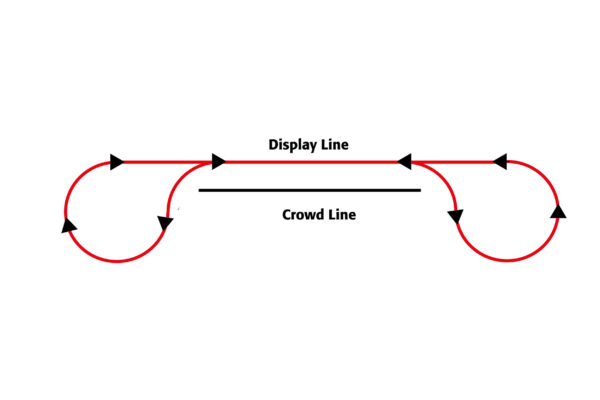Back in 2013 Brian Lecomber wrote his last column for FLYER. He passed away in September 2015, leaving the world poorer for his absence, but richer for the memories and writing he left behind. Brian spent many years on the circuit as a very accomplished member of the Rothmans aerobatic team, and of his own Firebird Aerobatic team.
In addition to his novels, Brian wrote about motoring and, of course, aviation. We’re reformatting his previous FLYER columns, this appeared in FLYER in December 2013.
Breakfast in the hotel is a rather subdued affair. Flying-suited figures enter the restaurant, wave vaguely to the other pilots already there, fetch orange juice and a fry-up from the buffet – and then, on their way to a seat, pause by one of the tall windows and stare out at the weather.
It is almost a religious ritual, this stare. As if the weather might have transformed itself magically in the few minutes since you last looked out of a window in your room. It hasn’t, of course. Still a gloomy cloudbase of maybe 300ft, dank drizzle and perhaps 3km of visibility if you have x-ray eyes.
Like death and taxes, this is one of those things which is going to happen. In all of the airshows in all of a summer there are going to be one or two – or more – which go pear-shaped due to weather. Murphy’s Law…
The grot has not changed when we pile out of the crew-bus and file into the display briefing room. The Met briefist – who at this stage is the only one of the several briefists most of us are actually interested in – is looking funereal. This is a semi-permanent state which some Met-men seem to acquire over years of handing out bad news.
And – to no-one’s surprise – today is one of those whens.
The rain might stop by late morning. Might. The cloudbase might slowly pick up to 500ft agl during the afternoon. Might…
The audience reaction to this is varied but universally wary. For some pilots this is a no-brainer. If a 500ft cloudbase – never mind 300ft – is below their cleared display minima, end of story. IF, of course, the forecast is correct. So they’ll spend the day glooming out of the pilots’ tent wondering if the weather might suddenly relent, leaving them to scramble in short order.
Others – especially in the Warbird community – will be doing much the same thing. For them the weather is obviously going to be a fine line between ‘Forget it’ and getting airborne and doing at least something, even if it’s just a few fly-bys. The fact that you get paid if you get airborne and you don’t if you don’t has no bearing on the airmanship decision, of course. Obviously not…
Flying certainly the most agile aeroplane in the show, I fall into a kind of different category. I will definitely be expected to perform unless the weather goes to 10 metres vis in wall-to-wall cat shit.
Looks like today’s gonna be a flat show.
On the face of it, flat shows are easy. None of these here Lomcovaks and other complicated exotica. Just get airborne, dumb-bell turn, line up on the display-line, roll, dumb-bell again, roll again going the other way.
Four-point roll, eight-point, multiple fast rolls – which require care lest they start to diverge – inverted passes, possibly the odd flick if you’ve got room for a slightly up-going line. And then you’ve just about shot your bolt. Nothing much else you can do. So easy-peasy, a flat show, right?
Wrong. Not easy-peasy. In fact a flat show can be quite a good way of rendering yourself extinct.
I wander out of the briefing, put on a baseball cap against the continuing drizzle and arrive, slightly damp, at the Extra. Push the tail round so that the soggy westerly will only pee on the outside of the sideways-opening canopy and not the inside, and climb into the cockpit. To think. And plan.
And remember Al Moon.
That was a flat show, although many years ago and many miles away. Al was flying a Pitts under a cloudbase not unlike today’s. He hauled out of a very steep turn and started a roll. The roll sank and he hit the ground in the third quarter. The dull clump was horrible to hear and the instantly blossoming fireball horrible to see. Sprinting pointlessly towards it I arrived far too late to do anything but watch as the fire crews doused the flames of Al’s cremation.
Easily done, that. Much more easily than you might think.
In my own mind, I am fairly sure what Al did – started the roll directly off the turn while still pulling at least residual positive g. And what does positive g do when you roll to inverted?
OK, you may say – but a good aerobatic pilot should be able to cope with a loaded-up roll entry. How else could he do a rolling circle, for example?
And you’d be right.
Except that a loaded-up roll entry is not a big deal (especially in a Pitts) if you were planning to do it. If you weren’t expecting it then that’s a whole different bowl of pistachios. And it doesn’t take more than two seconds for a Pitts to lose 100ft in a fouled-up roll. Especially if you are a bit groggy with g…
And in a flat show you always tend to be groggy with g.
Sounds ridiculous, doesn’t it? In a full show you might pull plus 8g and push minus 5 – and yet a flat show, with a max of about +6, is actually more arduous on your little frail human body. How can that be?
Well, the answer is exposure time. In an Unlimited aerobatic display the peak g levels happen when you’re pulling or pushing up. These peaks recur roughly 24 seconds apart, and last for maybe five / six seconds at max g.
In a flat show you’re theoretically pulling flat 180° turns at the end of each pass. Except that you’re not of course, or each run would be displaced laterally. What you’re actually doing is some sort of variation of a tear-drop turn – at its most extreme 90° (say) left followed by 270° right (see figs 2 and 3). And 90 plus 270 makes 360 – so you’re pulling the equivalent of a full high-g circle at each end of each pass. AND there are no zero g respites such as up-verticals. AND at an Extra’s median aerobatic speed of about 170kt you will traverse the display line in 12 to 15 sec, rolling, and then you’re back into the high g turn again.
Not restful. Eight minutes of that and it’s not entirely surprising that you feel like a short length of chewed string. You’ve swapped 20 or 25 bursts of very high g in a normal display for spending something like two-thirds of the performance under constant hefty g.
Do not expect your brain to be working with its normal razor-sharp acuity during this process.
(In fact, the Extra even manages to compound the problem by what is normally one of its great virtues – power. In a full solo display the throttle
only has one position – flat out – except for stall turns, tailslides and eventually the frippery of landing. In a flat show you need full power during the heavy turns – but if you leave it on during the level bits, albeit rolling, the bloody thing will accelerate like a Bugatti and present you at the next turn-around going 20kt faster. Which means even more g. So it leaves you in the ironic position of rolling out of this heavy full-power turn, chopping the power to about 50% for the actual rolling manoeuvre, and then ramming it on again for the next turn.)
So there are some safety lores for this forthcoming flat show. Not Laws, but Lores. Laws – legal laws – are things you obey unless you think you might get away with it. Lores, in our world, are how to keep a whole skin with a serviceable skeleton inside it.









